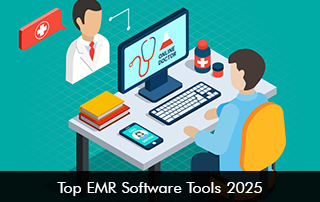With time, the technology of Electronic Medical Records (EMR) Software is being enhanced by the integration of innovative functionalities. These updated tools in EMR Software Systems aim to empower healthcare providers to boost patient care and create better avenues for patient engagement. Gone are the days when EHR Software was seen as digital storage for patient histories; now, it makes practices modern by being adaptable to the dynamic changes in healthcare.
In this blog post, we will explore the major EMR Software functionalities required this year and beyond. These tools are necessary to improve patient care and streamline workflows efficiently.
Artificial Intelligence Integration in EMR Software
AI in Electronic Health Records (EHR) Software is a must-have feature in 2025 and beyond. A good and updated EMR Software vendor will offer its users the features of voice-to-text tools, virtual assistants for automating complex tasks like coding and scheduling. Vendors such as eClinicalWorks EMR Software and Tebra EHR Software offer seamless AI integrations for swift documentation and automatic note generation. When documentation tasks are handled by AI, providers can give undivided attention to their patients. This is also critical to keep patents satisfied.
Robust Interoperability Options
Interoperability is the building block for seamless data exchange and to reduce any care gaps. A modern EHR Software vendor understands the importance of interoperability between hospitals, labs, and different specialists that can enhance patient care. In 2025, users, please ensure that the EMR Software System is compliant with FHIR standards for advanced data sharing capabilities.
Chatbots and Intuitive Patient Engagement Tools in EMR Software
AI-driven chatbots in EHR Software are a great way to enhance patient engagement and automate tedious workflows. The question is, how can chatbots interact with patients? It is simple; these chatbots use NLP to comprehend and respond to patient questions and queries. Chatbots in EMR Software are useful in helping patients through scheduling appointments and checking insurance eligibility. These also free up staff time, keeping workloads low.
Patient engagement tools are critical, such as secure messaging, a simple-to-use patient portal platform, and a telehealth facility. All these functionalities keep the patient at the center of care and prioritize their needs throughout their healthcare journey. For example, the MyChart Patient Portal is by Epic EMR Software, is extensively used by patients to book appointments, view lab results, pay bills, and interact with care teams.
Population Health Management and Predictive Analytics
Take predictive analytics tools in EHR Software as fortune tellers for health. These tools leverage AI to make guesses on what will happen to a patient; these tools do this by having access to past medical histories and records. For example, if a diabetes patient has missed their medication, the patient has a high chance of ending up in a hospital. Such early warning alarms can empower providers to step in and take proactive action.
Population health management dashboards in EMR Systems are a great way to keep track of how a certain group of people is doing. Though these dashboard providers can keep a check on who needs a flu shot, and which patients haven’t shown up for their cancer screenings.
EMR Software – The Future of Healthcare
As healthcare keeps evolving, clinicians need to utilize an EMR Software system with the above-mentioned tools and functionalities. These features can enable providers to stay at the forefront of care.








